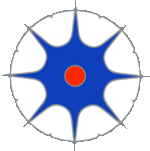This article needs additional citations for verification. (March 2021) |
 The Shodokan Aikido symbol | |
| Also known as | Tomiki Aikido |
|---|---|
| Date founded | 1958[a][1] or 1967[b][2][3] |
| Country of origin | |
| Founder | Kenji Tomiki (富木 謙治, Tomiki Kenji, 15 March 1900–25 December 1979) |
| Arts taught | Aikido |
| Practitioners | Tetsuro Nariyama, Fumiaki Shishida |
Shodokan Aikido (昭道館合気道, Shōdōkan Aikidō) is the style of Aikido founded by Kenji Tomiki.[2][4][5] Shodokan Aikido is sometimes referred to as 合気道競技 (Aikido Kyogi) meaning "Competitive Aikido" or "Sport Aikido" because of its use of regular competitions.[6][7]
The style itself could arguably have been founded with the formation of the Waseda University Aikido Club in 1958, although Tomiki didn't actually name his style Shodokan until 1976.[2][need quotation to verify] It was in 1967 when Kenji Tomiki established the Shodokan hombu dojo in Osaka, Japan, to teach, train and promote his style.[4] In 1974, Kenji Tomiki founded the Japan Aikido Association (NPO Japan Aikido Association). Since it was certified as a specified non-profit organization (NPO corporation) by the Cabinet Office in 2005, the official name was changed to "Specified Non-Profit Organization Japan Aikido Association". As of 2018, Masako Tomiki is the current chairman of JAA.
Today, Shodokan Aikido is organised with two major groups, the Japan Aikido Association (JAA)[6] and the Shodokan Aikido Federation (SAF).
Cite error: There are <ref group=lower-alpha> tags or {{efn}} templates on this page, but the references will not show without a {{reflist|group=lower-alpha}} template or {{notelist}} template (see the help page).
- ^ Bagot, Brian N.; McGlone, Paul (1992). Aikido: Traditional Art & Modern Sport. Crowood. p. 193. ISBN 9781852237158.
TOMIKI AIKIDO This style was founded by Professor Kenji Tomiki in 1958 at Waseda University.
- ^ a b c Shishida, Fumiaki; Nariyama, Tetsuro (March 1, 2002). Aikido: Tradition and the Competitive Edge. Shodokan Pub. p. 34-35. ISBN 978-0964708327.
- ^ Tomiki, Kenji (1991). 武道論 (Budō-ron) [Budo Theory] (in Japanese). University of Michigan: Taishukan Publishing. p. 284-285. ISBN 4469262153.
- ^ a b Jones, David (November 24, 2015). Martial Arts Training in Japan: A Guide for Westerners. Tuttle Publishing. p. 67-68. ISBN 9781462918287.
- ^ Cite error: The named reference
Habersetzer1was invoked but never defined (see the help page). - ^ a b Allen Guttmann; Lee Austin Thompson (2001). Japanese Sports: A History. University of Hawaii Press. p. 149-150. ISBN 9780824824648.
There are schools of aikido, however, that embrace the model of modern sports. After World War II, Tomiki Kenji, although he still considered himself a loyal disciple of Ueshiba, developed a competitive form of aikido. This occurred after he became a professor at Waseda University and sought to establish an aikido club for his students. He met initially with opposition on the grounds that aikido had not been modernized as a sport in the manner of jūdō and kendo. As a condition for permission to establish the club, the university insisted that Tomiki develop aikido as a sport. Responding to this demand, Tomiki set out to systematize aikido. He applied Kanō Jigoro's educational and ecumenical perspectives and modeled the techniques of aikido on those that had proven successful in the case of jūdō. In 1965, he publicized a competitive form of aikido that allowed sharp blows and pressure to joints. Since aikido had previously been practiced mainly through kata, the form developed by Tomiki was not widely accepted by other branches of the art. Tomiki's response to criticism was to establish the Japan Aikido Association (Nihon Aikido Kyōkai) to propagate competitive aikido. In the original form of competition that he developed, both contestants were barehanded, but the matches tended to resemble jūdō. In 1966, in order to underline the uniqueness of aikido, one of the contestants was given a rubber dagger. Formal competitions with the rubber dagger began in 1967. The annual All-Japan Student Aikido Tournament was begun in 1970 and the semi-annual National Adult Aikido Tournament in 1977.
- ^ Bryne, Brian (January 1, 1990). "Aikido Tournament Held in Japan". Black Belt Magazine. Active Interest Media, Inc. Retrieved November 11, 2024.
OSAKA, JAPAN - Aikido stylists from more than 16 countries came here recently for the first Tomiki Shotokan Aikido Tournament and Seminar. The tournament marked the tenth anniversary of the death of Kenji Tomiki, one of the first students of aikido founder Morihei Uyeshiba[sic] and the innovator of "sport" aikido. Tomiki aikido is a more linear form of the art which has roots in jujitsu and kendo, and focuses on joint locks, submission holds, and throws. The style allows for competition with a reduced risk of injury. The event featured the traditional randori competition, in which a knife-wielding assailant tries to score by stabbing the defender, who earns points by executing clean aikido techniques to defuse the attack.